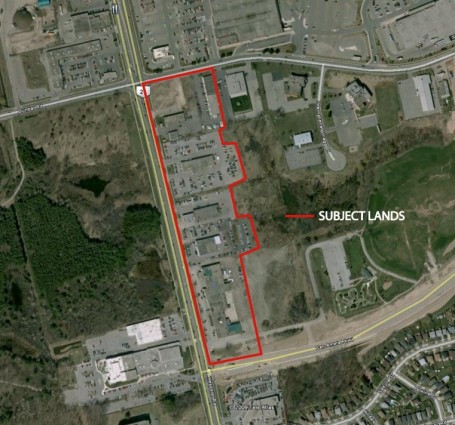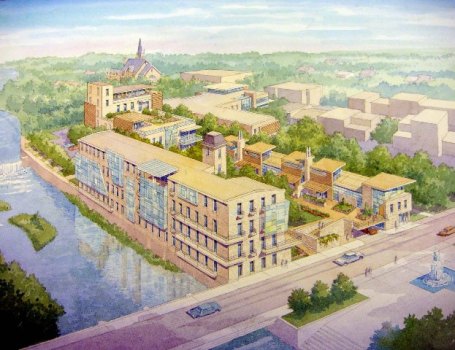Posts tagged ‘Brownfield’
Browfield Research to be Conducted by University of Western Ontario
Innovative new techniques to neutralize contaminated “brownfield” industrial sites and toxic hotspots such as the Port Stanley harbour are being devised at the University of Western Ontario.
A few examples of how to remove contaminants include; bombarding the chlorinated solvents found at most former industrial sites with tiny “nanoparticles” engineered to react chemically and eliminate the pollution, said researcher Jason Gerhard. A second approach, said the geo-environmental restoration engineer, is to burn carbon-based contaminants such as coal tar where they lie. Through the principle of “self-sustaining smoldering,” the tar is consumed.
The idea behind the research, funded by $4.5 million in grants from governments and the private sector, is to develop modern, cost-effective approaches to deal with contaminated sites without digging up toxins and exposing the public to them.
Port Stanley, with its witches’ brew of contaminants, is an ideal site for real-world trials, he conceded. In fact, preliminary work is under way.
Source: LFPress.com
HydroCity Lecture
November 5, 2009 – 6:30pm
Main Lecture Theatre, UW Architecture Building
Cambridge
The HydroCity Lecture, a Symposium on Hydrology and Urbanism, is presented in conjunction with a Symposium to be held at the University of Toronto on November 6, 2009.
Alan Berger is Associate Professor of Urban Design and Landscape Architecture at Massachusetts Institute of Technology where he teaches courses in the department of urban studies and planning. He founded and directs P-REX, The Project for Reclamation Excellence at MIT, a trans-disciplinary research effort focusing on the design and reuse of waste landscapes worldwide. By using low-angle aerial photography, maps, and other graphic evidence, Berger visually reveals evidence and trends of landscape waste throughout the world—from public health hazards such as abandoned mine pits, mountains of slag, and pools of cyanide, to vacant land, landfills, military installations, and places associated with high and low-density urbanization. How these sites are cleansed, valued and considered for adaptive reuse at local and regional scales is Berger’s main area of interest. His work emphasizes the link between our consumption of natural resources, and the waste and destruction of landscape, to help us better understand how to proceed with redesigning our wasteful places for future productive uses and more sustainable outcomes. He has coined the term “Systemic Design” to describe the productive integration of disvalued landscapes into our urbanized territories and regional ecologies. Berger currently serves as a consultant to the U.S. Environmental Protection Agency on Brownfield and Superfund site revitalization in the American landscape.
Berger’s award winning books include Drosscape: Wasting Land in Urban America, and Reclaiming the American West (PAPress 2006, 2002 respectively) His other books include Designing the Reclaimed Landscape, published (Taylor & Francis 2008) and Nansha Coastal City: Landscape and Urbanism in the Pearl River Delta (Harvard Design School 2006).
Prior to coming to MIT he was Associate Professor of Landscape Architecture at the Harvard-GSD, 2002-2008. He has been Distinguished Visiting Professor of Landscape Urbanism at Oslo School of Architecture in Norway, and at Aarhus School of Architecture in Denmark. He was Distinguished Visiting Professor of Sustainability at University of Michigan’s Taubman School of Architecture, and Visiting Professor for Landscape Urbanism at Katholike University in Leuven-Belgium. He is a Prince Charitable Trusts Fellow of The American Academy in Rome.
A Call to Design: Dunbar Collective

Dunbar Collective: Site Location
I want to ask you the readers if you have a design solution for this location?
I want to create a green technology showcase property for City of Cambridge and hopefully this can be a catalyst project for the rest of Hespeler Road. Maybe this project could be included in the Mayor’s new “green” agenda?!
This project will create some much needed infill and intensification development as well as showcase new technologies through building design, energy systems and sustainability.
Perhaps work towards a LEED certified building(s)?
Site Details
Size: Unknown (I do not have the proper tools at home to calculate it!)
Current Zoning: Commercial, I’m assuming “automotive related”
Potential Zoning: Live/Work units
Transit: iXpress and GRT transit stops already in place at Cambridge Centre Mall, located relatively close to the 401
Other Details:
- More than likely a low-level brownfield site
- Gas station used to be located on corner of Dunbar Road and Hespeler Road
- Several automotive related services were located on properties south of Dunbar, but before the recently closed Galt Chrysler Car Dealership
- “Junky” flea market located at corner of Can-Amera Parkway and Hespeler Road
- YMCA is across the street
- Dumfries Conservation Area located across the street, approximate size of 75 hectares
- New residential towers built at Dunbar and Conestoga Boulevard
- Regional Shopping Centre (Cambridge Centre Mall) located across the street
I’m going to work on drafting some concepts, but I would also love to see your work too!
PCB Dome to Become a Sportsplex?
I like the idea of reuse and recycle, and this fits that train of thinking very well.
Northeast London could become home to an all-weather sports facility capable of housing two football fields or soccer pitches and a running track. That’s the dream of a London labour leader and an MPP as they eye a future use for a huge structure – intended to be temporary – that has enclosed the $63 million cleanup of Ontario’s largest PCB dump. “I’ve spoken to the minister of the environment and he is interested in working with us,” said London-Fanshawe Liberal MPP Khalil Ramal. Ramal and Chris Bentley, the attorney general and Liberal MPP for London West, are working to pull together a meeting of all parties, including the Environment Ministry, the contractor, planning and parks and recreational staff from city hall to see if the idea is worth pursuing.
Ramal said using provincial land for sports in London is not farfetched. He noted soccer groups have an arrangement to use provincial land at the north end of what used to be London Psychiatric Hospital at Highbury Ave. and Oxford St..
Environment Ministry official Mike Moroney, who chairs a citizen group overseeing the cleanup, said the site is zoned industrial and the cleanup is being done to an industrial standard so further work would likely be needed to achieve a recreational standard.
Source: LFPress.com
A Changing Hespeler Skyline

Shawky Fahel, a local developer in Waterloo Region has bought the existing American Standard building in Hespeler and has grand plans for the redesign of the factory’s site. The first draft plan includes approximately 95 housing units and 7,000 square feet of retail space fronting Queen Street. Fahel is also thinking that part of the building might become “transitional housing” for seniors who want to leave their homes, but aren’t ready to move into a nursing home.
With its location on Speed River, the building will be turned into 34 apartment units with studios and storage units on the ground floor. A second large stone building at the east end of the property will be remodeled to incorporate 33 apartment units. Adjacent to it and running along the south side of the property, will be another two-storey stone building with 12 townhouse units. A fourth large building facing Queen Street will be saved and re-used with 16 residential condominium units at the rear of the building and retail/commercial space on Queen Street.
The project is now dubbed 1847 Riverbank, and “keeps the four best-crafted buildings in this industrial campus”, while demolishing the centre of the existing structure to create a two-storey, 141 space parking structure with rooftop terrace.
“We want condominiums and mixed use. The building lends itself very well to that,” Fahel said. It’s amazing to finally here those words come out of a developers mouth in the Region.
The site currently is contaminated but has been described as being “manageable” and GSP Group will be working with the ministry over the next six to eight months to complete the required record of site condition.
Construction is slated to start at the beginning of 2010 and Fahel said the apartments will be competitively priced.
Finally Hespeler you have something to be proud of other than your hockey.
Source: CambridgeTimes.ca
Aclo Compounders sold, potential brownfield redevelopment opportunity
It’s only hearsay currently, but Aclo Compounders Inc. in Cambridge has been sold to an American company who is moving the operations to Guelph, Ontario. There have been rumours of turning the old George Pattinson & Co. woollen mill and former landfill site into a brownfield redevelopment project. I don’t have any plans or know much more other than what I’ve heard through the grapevine, but it would be a nice way to keep the architectural landmark from becoming another run down abandoned factory.

